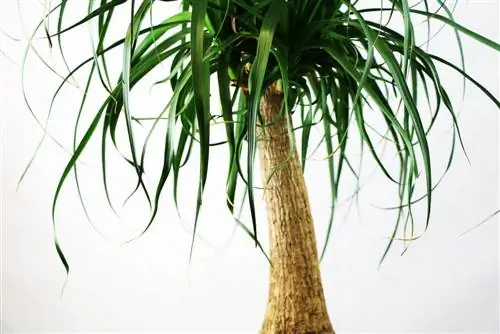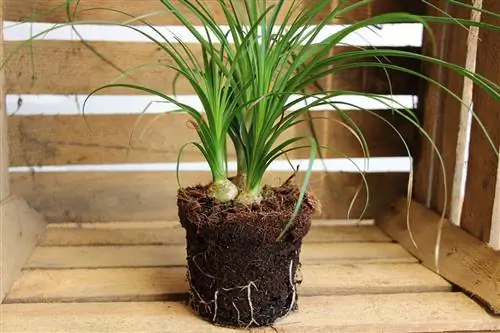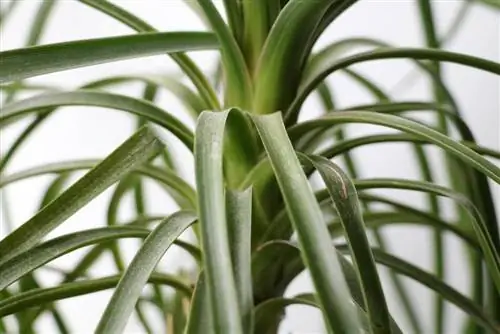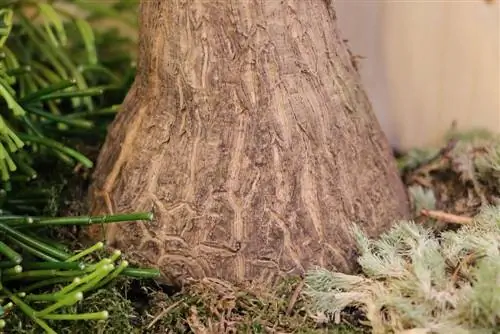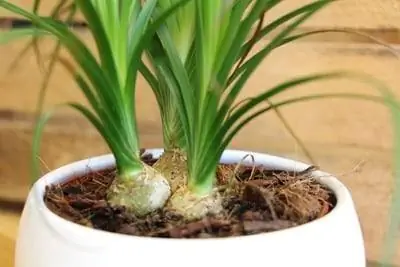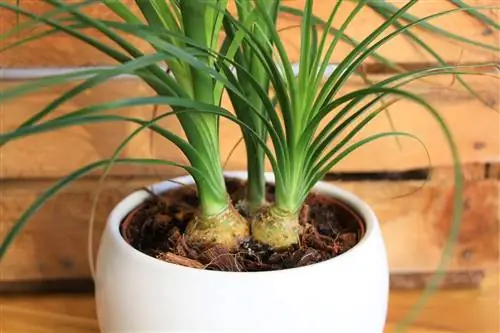- Author admin [email protected].
- Public 2023-12-17 03:39.
- Last modified 2025-01-24 12:45.
Why do we like the elephant foot so much? Maybe because this desert dweller from America provides us with many contrasts: the trunk is light brown, the leaves are rich green. The trunk is chunky and the leaves are delicate. The trunk stands upright, the leaves hang down. It really looks like it was sculpted by an artist. And the matching bowl sets everything off.
Origin and growth
The elephant foot plant does not come from Africa, like the animal elephant. It got this unusual name only because its trunk looks like an elephant's foot. Mexico and the southern United States are the true home of this popular houseplant. In the wild, the elephant's foot can grow up to nine meters high and have a trunk diameter of one meter. Nevertheless, this plant also develops well indoors, is actually quite undemanding and forgives the occasional care mistake. As a room decoration, the elephant foot grows very slowly and is only about 1.5 meters tall. So compact it can become a permanent resident.
Does the elephant foot need to be repotted?
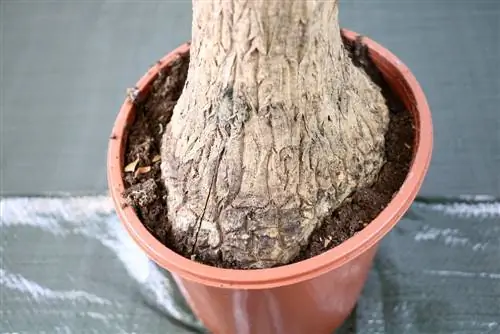
The elephant's foot grows slowly. He only pushes the leaves up in front of him in small pieces. The trunk also only grows stronger and wider at a snail's pace. However, what it lacks in terms of growth is reliably provided by time. Over the years, the elephant's foot reaches a respectable size, even if it grows up in a pot and in closed rooms. At some point it can no longer be avoided that the current pot no longer fits your foot like a glove, that it squeezes it and leaves no room for your roots.
When the time comes, the elephant's foot urgently needs to get rid of its old pot and move into a suitable one. Therefore, the answer is: Yes, an elephant's foot also needs to be repotted regularly, although not as often as other plants require their owners.
The ideal time
The elephant's foot, which was christened with the beautiful botanical name Beaucarnea recurvata, clearly shows when it is running out of space.
- the thickened lower end of the trunk has grown almost to the edge of the pot
- the roots try to free themselves from the too tight pot and grow out
The ideal time to free an elephant tree from its confines is spring from the end of February to mid-March. During the cold season, the elephant's foot lived on the back burner. When the days get longer again and more light falls into the room from outside, the elephant's foot also comes back to life. A new growing season begins. It's good if a new pot offers the necessary development space at the beginning of this phase.
The optimal pot size
The pot is above all a space that allows the roots to develop. The native environment of the elephant's foot, also known colloquially as a bottle tree because of its appearance, provides important clues when choosing the right pot size. There, in Mexico, it grows on poor, dry and hard soils. Its roots are used to laboriously fighting and fighting their way, while parallel to this the upper part of the plant grows and develops new leaves.
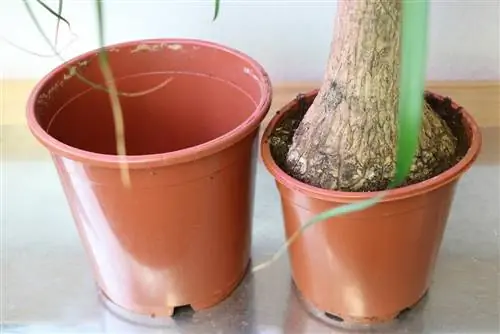
The shallow-rooted elephant's foot shouldn't be made too easy at home in the pot. A very large pot with soft soil is his El Dorado. The roots meet no resistance, they grow and grow. All available energy goes into root formation, the rest switches to economy mode. It is precisely the beautiful trunk and the tuft of green leaves that delight all plant lovers. The roots are important, but the necessary amount is enough. Therefore, choose a pot that is only slightly larger than the old pot. In this way you stimulate the entire growth, from the roots to the green head.
- flat and wide bowl looks good with the bottle shape of the elephant foot
- new bowl must be a little deeper than the old bowl
- Pails are also suitable
- too much space in the depth can/should be filled with stones
The suitable substrate
The elephant tree should not be repotted in pure potting soil. It is naturally used to stony and barren soil conditions and should be able to reproduce these environmental conditions in the pot. There are several options for selecting the substrate. Which substrate is ultimately used can be determined by the owner's individual preferences. Maybe there is enough suitable soil left over from other plants.
- good cactus soil provides it with the ideal composition
- Pot soil is also possible
- alternatively potting soil with 30% sand content
- or your own mixture of sand, leaf mold and calcareous clay
Stones should also be added to the substrate. It is best to place a whole layer of stone in the pot before adding the potting soil over it. The stones have a dual function. On the one hand, as a drainage layer, they ensure good drainage and prevent waterlogging from forming. On the other hand, the stones are impenetrable for the roots and thus provide resistance. This is particularly important if a fairly deep pot is used and excessive root growth is to be contained.
Repotting step by step

If the elephant's foot needs a new pot, repotting is quick and relatively easy. Keep the new pot and substrate within easy reach to make repotting as easy and as clean as possible. If your bottle tree is already quite large, it might be a bit unwieldy. Maybe an extra helping hand could be useful. Sometimes you need both hands to free the root ball from the tight pot while another person holds the plant. If the plant falls over during this action, its leaf canopy in particular can be damaged. Even if the elephant's foot is placed in a new pot, the helper can keep the trunk straight while the pot is still filled with soil.
- Choose a new, suitable container.
- Get the right soil.
- Place a layer of stones at the bottom of the vessel.
- Then fill in about soil.
- Carefully get the elephant foot out of the old pot.
- Remove its roots completely from the old substrate.
- Place the elephant foot in the new pot.
- Align the plant and keep the trunk straight.
- Now fill the gaps with soil.
- Press the soil firmly.
- The repotted bottle tree should then receive a good load of water.
Tip:
Tap the wall of the container as you fill it with soil. This way the earth slides better into all the gaps. The trunk should stick out in its new container just as far as it did in the old container. So don't insert it deeper! If it is too deep, fill in some soil first or increase the drainage layer of stones.
Choosing the right location

Now all you have to do is give this desert exotic its place back. However, repotting is also a good opportunity to critically question the current location. Will the elephant foot still have enough space for further growth.
Are the lighting conditions really good, or is there still a need for optimization?
The elephant's foot likes bright locations where it gets enough sunlight in the morning and evening. He doesn't tolerate the blazing sun at midday very well as a roommate. If your elephant foot has spent the winter in the dark before repotting, it must first be carefully acclimated to the sun.
Care after repotting
Freedom of roots is within reach with the new pot, it should and can now be fully enjoyed. The owner's hope that the visible part of the plant will now also make a strong impression should also be fulfilled. However, he can't sit back and wait now; he has to actively help, because repotting alone isn't enough. In order for the roots to grow well, care must be right. In this way, the growth potential can be optimally developed in the upcoming growing season:
- he doesn't need much water
- either always keep it slightly moist
- or (especially in summer) water heavily again and again
- let it almost dry out in between
- endures long dry spells
- fertilize about weekly with fertilizer for green plants
The roots will definitely get used to their new home quickly. The trunk and leaves will also benefit. You can enjoy this magnificent inhabitant of the desert in the current pot for another four to five years, after which it will definitely be time for a new one.

